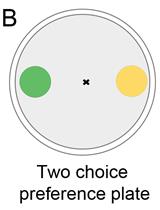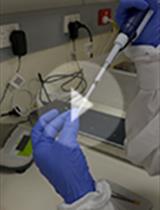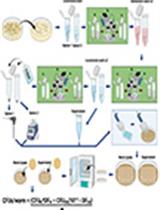- EN - English
- CN - 中文
Culturing Bacteria from Caenorhabditis elegans Gut to Assess Colonization Proficiency
利用秀丽隐杆线虫肠道培养细菌以评估其定植能力
发布: 2017年06月20日第7卷第12期 DOI: 10.21769/BioProtoc.2345 浏览次数: 16229
评审: Jyotiska ChaudhuriJian ChenLeonardo G. Guilgur
Abstract
Determining an accurate count of intestinal bacteria from Caenorhabditis elegans is one critical way to assess colonization proficiency by a given bacteria. This can be accomplished by culturing appropriate dilutions of worm gut bacteria on selective or differential agarized media. Because of the high concentration of bacteria in gut worm, dilution is necessary before plating onto growth media. Serial dilutions can reduce the concentration of the original intestinal sample to levels low enough for single colonies to be grown on media plates, allowing for the calculation of the initial counts of bacteria in the intestinal sample.
Keywords: Caenorhabditis elegans (秀丽隐杆线虫)Background
Animals rarely live in isolation but rather exist in association with microorganisms. The more characteristic host-microbe interaction in nature is the symbiotic relationship between host and intestinal microbiota (Rosenberg and Zilber-Rosenberg, 2011). In mammals, host-microbe symbiotic interactions mainly occur along mucosal surfaces, with the most important one being the intestinal mucosa. When freshly isolated from the wild, C. elegans often harbours a diverse bacterial flora in its gut lumen, reminiscent of the microbial communities of higher organisms (Duveau and Felix, 2012; Bumbarger et al., 2013). By contrast, in the laboratory C. elegans is typically maintained in the presence of single bacterial strain (Brenner, 1974). Most often, this is the Gram-negative bacterium Escherichia coli. However, other species are sometimes used, such as the Gram-positive Bacillus subtilis (Garsin et al., 2003). An adult worm contains approximately 10,000 bacterial cells, a number 10-times greater than that of host worm somatic cells (Portal-Celhay and Blaser, 2012): perhaps coincidentally, this microbiota-to-host cell ratio is similar to that found in humans.
Different strategies are being used to measure the colonization proficiency of C. elegans gut by a bacterium such as fluorescein isothiocyanate (FITC)-labelled bacteria, bacteria expressing a fusion reporter (green fluorescent protein [GFP] or β-galactosidase). However, the more accurate method is to measure the number of CFU isolated from the worm intestine. In this protocol, we show how to isolate and count E. coli and B. subtilis strains from C. elegans gut. In the case of B. subtilis, we also show how to distinguish vegetative forms from highly resistant spores formed by this bacterium inside the C. elegans gut.
Materials and Reagents
- Pipette tips 2-200 µl Eppendorf® epT.I.P.S. (Eppendorf, catalog number: 022492039 )
- Pipette tips 50-1,000 µl Eppendorf® epT.I.P.S. (Eppendorf, catalog number: 022492055 )
- Petri dishes 60 x 15 mm 500/cs (Fisher Scientific, catalog number: FB0875713A )
- Petri dishes 35 x 10 mm 500/cs (Fisher Scientific, catalog number: FB0875711YZ )
- Corning® 15 ml centrifuge tubes (Corning, catalog number: 430791 )
- Eppendorf® Safe-Lock 1.5 ml microcentrifuge tubes (Eppendorf, catalog number: 022363204 )
- Toothpick
- 99.95 % Platinum, 0.05 % Iridium wire (3 ft/pk) (Tritech Research, catalog number: PT-9901 )
- OP50 E. coli bacteria (University of Minnesota, C. elegans Genetics Center, MN)
- Experimental and control C. elegans strains (University of Minnesota, C. elegans Genetics Center, MN)
- Sodium chloride (NaCl) (Sigma-Aldrich, catalog number: S7653 )
- Bacto peptone (BD, BactoTM, catalog number: 211677 )
- Agar (Sigma-Aldrich, catalog number: A1296 )
- Hypochlorite (Sigma-Aldrich, catalog number: 13440 )
- Commercial Bleach 60 g/L (DROGUERÍA INDUSTRIAL SAN JUAN, http://www.sanjuandrogueria.com)
- Triton X-100 (Sigma-Aldrich, catalog number: X100 )
- Luria broth (Sigma-Aldrich, catalog number: L3522 )
- Luria broth with agar (Sigma-Aldrich, catalog number: L2897 )
- Lysozyme from chicken egg white (Sigma-Aldrich, catalog number: L6876 )
- Sodium phosphate dibasic (Na2HPO4) (Sigma-Aldrich, catalog number: S3264 )
- Potassium phosphate monobasic (KH2PO4) (Sigma-Aldrich, catalog number: P5655 )
- Cholesterol (Sigma-Aldrich, catalog number: C8667 )
- 100% ethanol (Sigma-Aldrich, catalog number: E7023 )
- Magnesium sulfate heptahydrate (MgSO4·7H2O) (Sigma-Aldrich, catalog number: M1880 )
- Calcium chloride dihydrate (CaCl2·2H2O) (Sigma-Aldrich, catalog number: C3881 )
- Potassium phosphate dibasic (K2HPO4) (Sigma-Aldrich, catalog number: P2222 )
- Sodium hydroxide (NaOH) (Sigma-Aldrich, catalog number: S8045 )
- Levamisole hydrochloride (Sigma-Aldrich, catalog number: L0380000 )
- Nematode growth medium (NGM) (see Recipes)
- M9 buffer (see Recipes)
- 5 mg/ml cholesterol (see Recipes)
- 1 M MgSO4 (see Recipes)
- 1 M CaCl2 (see Recipes)
- Phosphate buffer (see Recipes)
- 1 N NaOH (see Recipes)
- 25 mM Levamisole (see Recipes)
Equipment
- Erlenmeyer flask (Fisher Scientific, catalog number: FB5006000 )
- Pipettor (Gilson, catalog number: F167300 )
- Worm pick. Worm picks can either be purchased (Genesee Scientific, catalog number: 59-AWP ) or made in the lab as described in Wollenberg et al., 2013
- Pasteur glass pipette (Fisher Scientific, catalog number: 22-378893 )
- Autoclave (Tuttnauerusa, model: 6690 )
- Stirring hotplate (Corning, catalog number: 6795-620 )
- Centrifuge (Eppendorf, model: 5430 )
- Tabletop centrifuge (Eppendorf, model: 5424 )
- Pellet pestle (Kimble Chase Life Science and Research Products, catalog number: 7495211590 )
- Refrigerated incubator (Thermo Fisher Scientific, Thermo ScientificTM, model: HerathermTM General Protocol Microbiological Incubators , catalog number: 51028064)
- Bunsen burner (Humbolt, catalog number: H-5870 )
- Dissecting stereomicroscope (Olympus, model: SMZ645 )
- Incubators for stable temperature (AQUA® LYTIC incubator 20 °C)
- Freezers (-20 °C; So-Low Environmental Equipment) (Siemens, model: C85-22 )
- Water bath
Procedure
文章信息
版权信息
© 2017 The Authors; exclusive licensee Bio-protocol LLC.
如何引用
Rodriguez Ayala, F., Cogliati, S., Bauman, C., Leñini, C., Bartolini, M., Villalba, J. M., Argañaraz, F. and Grau, R. (2017). Culturing Bacteria from Caenorhabditis elegans Gut to Assess Colonization Proficiency. Bio-protocol 7(12): e2345. DOI: 10.21769/BioProtoc.2345.
分类
微生物学 > 微生物-宿主相互作用 > 线虫
细胞生物学 > 细胞分离和培养 > 细胞生长
您对这篇实验方法有问题吗?
在此处发布您的问题,我们将邀请本文作者来回答。同时,我们会将您的问题发布到Bio-protocol Exchange,以便寻求社区成员的帮助。
Share
Bluesky
X
Copy link




















